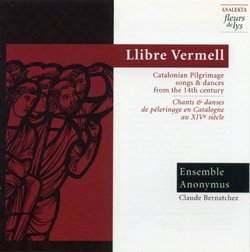| All Artists: Llibre Vermell de Montserrat Anonymous, Claude Bernatchez, Ensemble Anonymus Title: Llibre Vermell Members Wishing: 0 Total Copies: 0 Label: Analekta Release Date: 4/5/2007 Genres: Dance & Electronic, Special Interest, Pop, Classical Styles: Vocal Pop, Opera & Classical Vocal Number of Discs: 1 SwapaCD Credits: 1 UPC: 774204305529 |
Search - Llibre Vermell de Montserrat Anonymous, Claude Bernatchez, Ensemble Anonymus :: Llibre Vermell
 | Llibre Vermell de Montserrat Anonymous, Claude Bernatchez, Ensemble Anonymus Llibre Vermell Genres: Dance & Electronic, Special Interest, Pop, Classical
|
Larger Image |
CD Details |
CD ReviewsMedieval folk songs -- fresh and charming Nowhere Man | 11/01/2009 (5 out of 5 stars) "Llibre Vermell de Montserrat (which is the Catalan for "Red Book of Montserrat") is a collection of late medieval songs. The 14th century manuscript, located at the monastery of Montserrat (close to Barcelona, in Catalonia, Spain) was placed in the 19th century in a red binding, hence the name of the collection. (The monastery of Montserrat holds the shrine of the Virgin of Montserrat, which was a major site of pilgrimage during the time the collection of songs was compiled.)
The manuscript, prepared in 1399 (approximately), originally contained 172 double pages, of which 32 have been lost. No composer is identified for any of the songs it contains. The songs were written for the pilgrims to have something appropriately "chaste and pious" to sing. They are in Catalan, Occitan and Latin. Although the collection was written near the end of the 14th century, much of the music in the collection appears from its style to originate earlier: the motet 'Imperayritz de la ciutat joyosa' contains two different texts which can be sung simultaneously (a style considered old fashioned when the manuscript was compiled). The songs have many of the characteristics of folk songs as well as hymns. Some are monophonic, while others are set in two to four parts of polyphony. Some of the monodic songs can be sung as canons. The songs' simplicity, harmony and strong melodies have given the music collected in the Llibre Vermell a lasting appeal, and these songs appear to be some of the most frequently recorded pieces of early music. Many musicians have performed these songs and this disc contains one of the most noteworthy interpretations: accurate, clean, clear, sparkling and intuitive. But its geatest qualities are the purity of sound and freshness: listening to the songs, one feels transposed in those times of quest, contemplation and faith. " |

 Track Listings (14) - Disc #1
Track Listings (14) - Disc #1